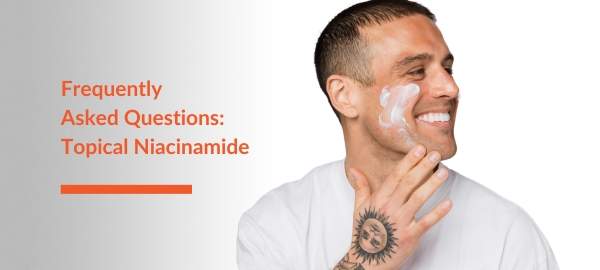We get a lot of questions about topical Vitamin B3 (niacinamide) and how it helps support sun-damaged skin. So we asked our CEO and pharmacist, Doug, to explain what makes niacinamide such a powerful ingredient and answer some of the most common queries we hear about the SolarCareB3 range.
Q: Why is Vitamin B3 so good for sun damage?
A: Sun damage doesn’t show up in just one way—it can look like dark spots, redness, uneven tone, fine lines, rough texture, or a loss of elasticity. Just as UV exposure causes multiple issues at once, niacinamide works holistically to repair and protect. It supports DNA repair, strengthens the skin barrier, reduces pigmentation, improves texture, and helps restore skin resilience over time.
Q: How does niacinamide help with hyperpigmentation?
A: Niacinamide regulates melanin transfer, which prevents excess pigment from building up in the skin. This helps fade dark spots, even out tone, and reduce the chance of new pigmentation forming—making it ideal for sunspots, post-inflammatory hyperpigmentation, and uneven skin tone.
Q: What does niacinamide do for hydration and the skin barrier?
A: Vitamin B3 helps boost ceramide and lipid production, reinforcing the skin’s natural barrier. This improves moisture retention, reduces water loss, and enhances overall hydration—leaving skin feeling softer, smoother, and more resilient.
Q: How does B3 support inflammatory skin conditions?
A: Niacinamide has anti-inflammatory properties that help calm redness, irritation, and sensitivity. It’s especially helpful for skin prone to rosacea, eczema, or acne, as it can reduce flare-ups and strengthen the skin’s defences.
Q: What about fine lines and signs of ageing?
A: By supporting collagen production and barrier repair, niacinamide can improve skin elasticity and firmness. It helps refine texture, smooth fine lines, and promote long-term skin renewal—making it a valuable addition to any age-support routine.
Q: How should I use B3?
A: Niacinamide is well tolerated by most skin types, including sensitive, oily, dry, and combination. For best results, choose a 5% or higher topical formula like SolarCareB3 (available in 5% and 10%) and apply morning and night for at least three months. Continued, long-term use can help maintain healthier, more even-toned skin. If appropriate, you might also consider pairing it with oral Vitamin B3.
In summary:
Sun damage isn’t just skin deep—it affects the skin’s barrier, immune function, and ability to repair itself. Niacinamide helps by supporting DNA repair, boosting hydration, calming inflammation, and reducing the visible signs of damage like uneven tone, fine lines, and texture changes.
For best results, use SolarCareB3 twice daily and continue long-term for lasting support.
Want to know more about oral niacinamide and how it works from within? Read our guide here.
